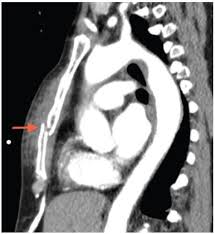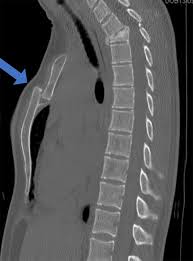
 A sternal fracture is a fracture of the sternum located in the center of the chest.
A sternal fracture is a fracture of the sternum located in the center of the chest.
The injury, which occurs in 5–8% of people who experience significant blunt chest trauma, may occur in vehicle accidents, when the still-moving chest strikes a steering wheel or dashboard or is injured by a seatbelt.
Cardiopulmonary resuscitation (CPR), van cause thoracic injury, including sternum and rib fractures.
Sternal fractures may also occur as a pathological fracture, in people who have weakened bone in their sternum, due to another disease process.
Sternal fracture can interfere with breathing by making it more painful.
The primary significance of sternal fracture is that it can indicate the presence of serious associated internal injuries, especially to the heart and lungs.
Signs and symptoms include crepitus, the crunching sound made when broken bone ends rub together.
Pain, tenderness, bruising, and swelling over the fracture site may occur.
The fracture may visibly move when the person breathes.
Sternal fractures may lead to a bent or deformed sternum, that is detectable by palpation.
The upper and middle parts of the sternum are those most likely to fracture.
Most sternal fractures occur below the sternal angle.
Sternal fracture is commonly associated with injuries to the heart and lungs; injuries such as myocardial and pulmonary contusions are likely.
Other associated injuries include: damage to blood vessels in the chest, myocardial rupture, head and abdominal injuries, flail chest, and vertebral fracture.
Sternal fractures may also accompany rib fractures.
Sternal fractures are associated with high-energy injuries that could cause bronchial tears.
When there are associated injuries with sternal fracture the mortality rate for people is high, at an estimated 25–45%.
When sternal fractures occur in isolation, their outcome is very good.
Vehicle collisions are the usual cause of sternal fracture.
Sternal fractures are estimated to occur in about 3% of auto accidents.
The chest of a driver may be injured by striking the steering wheel, seat belt and the shoulder component of a seatbelt if it is worn without the lap component.
The safety belt syndrome, is a pattern of injuries caused by seat belts in vehicle accidents.
The injury can also occur when the chest suddenly flexes, in the absence of an impact.
In the case of an injury sustained during CPR, sternal fractures have an incidence between 1% to 43%.
Injury to the sternum may be made more likely if there are other disease processes in place that have weakened the bone.
X-rays of the chest and CT scanning are indicated.
X-rays taken from the front may miss the injury, they are taken from the side as well.
Management involves treating associated injuries.
Because it is common for cardiac injuries to accompany sternal fracture, heart function is monitored with electrocardiogram.
Fractures that are very painful or extremely out of place can be operated on to fix the bone fragments into place.
Most cases treatment consists mainly of reducing pain and limiting movement.
A severe fracture may interfere with breathing, requiring tracheal intubation and mechanical ventilation.
People who experience a pathologic fracture will be investigated for the cause of the underlying disease.
